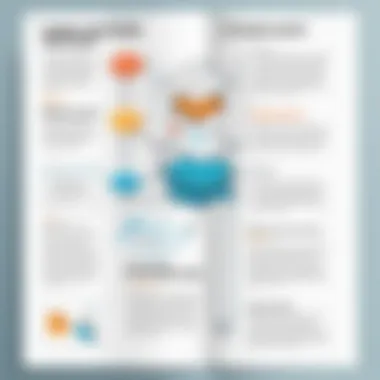Mastering PDF Management with Python Libraries


Foreword to Programming Language
When discussing PDF file management, one can't ignore the role of Python in today’s programming landscape. It's more than just a programming language; it’s a tool that simplifies many complex tasks.
History and Background
Python was conceived in the late 1980s by Guido van Rossum, and it has grown exponentially ever since. Unlike other languages that might have a steep learning curve, Python was designed with simplicity in mind. Its clean syntax and readability make it an ideal choice for those diving into programming. In its early days, Python was primarily used for scripting in Unix environments, but it has since evolved into a powerhouse, finding applications in web development, data analysis, and yes, handling PDF files as well.
Features and Uses
Python shines in various areas:
- Ease of Learning: Its simplicity allows new programmers to grasp concepts quickly.
- Versatility: Python can be used in multiple domains, such as automation, data science, and web development.
- Rich Libraries: There’s a library for almost anything. When it comes to PDFs, libraries like PyPDF2 and ReportLab stand out.
This versatility and rich feature set make Python an essential tool for both newcomers and seasoned professionals.
Popularity and Scope
Python's popularity has surged in the past decade. According to the TIOBE Index, it has been among the top programming languages. Its community is vibrant, contributing to a plethora of open-source libraries. People in different sectors, from finance to education, are now leveraging Python due to its power and simplicity. The demand for Python developers is also at an all-time high, making it a favorable career choice for those starting their journey in programming.
"Python is not just a language; it's a philosophy of simplicity."
When it comes to manipulating PDF files, Python's capabilities can be found in its libraries. Understanding how to use these tools is a gateway for programmers looking to manage documents effectively. In the next sections, we'll cover the building blocks and tools that make handling PDFs a straightforward task.
Prologue to PDF and Python
When it comes to handling documents in the digital age, few formats can match the prowess of the Portable Document Format, better known as PDF. The significance of PDFs stretches beyond mere aesthetics. They maintain their layout across various platforms, guaranteeing that what you see is what you get, whether on a computer, a tablet, or a smartphone. This is particularly crucial in professional contexts, where the integrity of documents matters immensely.
Python, a programming language revered for its simplicity and versatility, has emerged as a powerful ally in handling PDF files. This guide centers around the best practices and essential libraries associated with PDF manipulation in Python. The blend of Python's straightforward syntax and the complexities of PDF management creates an engaging challenge for programmers. Students and budding developers will find that understanding this relationship not only enhances their skill set but also opens the door to a wide array of applications, from report generation to data extraction.
In short, navigating the realm of PDFs with Python could prove invaluable in many programming tasks that involve document processing. Let's dive deeper into what PDF files are and why Python is a fitting choice to work with them.
Understanding PDF Format
The Portable Document Format, created by Adobe in the early 1990s, was designed to enable users to share documents across varying systems without loss of formatting. This makes PDF a go-to choice for many businesses and individuals alike. The format encapsulates a rich array of elements.
- Text content: Encoded in a way that retains the appearance regardless of the reader's device.
- Images and Graphics: Supports various image formats, allowing for customization and branding.
- Interactive elements: PDFs can include hyperlinks, forms, and annotations, which are integral for user engagement.
From forms and legal documents to brochures and reports, PDFs serve a myriad of purposes. Additionally, PDFs can be compressed, ensuring that large documents remain manageable. Understanding the intricacies of this format is essential for anyone looking to manipulate PDFs through programming.
Significance of Python in Document Handling
Python stands out as a formidable language for document management due to its extensive library support and ease of use. It provides tools that make it relatively straight-forward to create, read, and manipulate PDFs without deeply delving into complex coding paradigms.
Key reasons Python is significant in document handling include:
- Rich Libraries: Python boasts libraries like PyPDF2, ReportLab, and pdfminer which simplify the complexities involved in handling PDFs.
- Simplicity: Python’s syntax is relatively clean, meaning less confusion for new programmers trying to grasp the nuances of document manipulation.
- Community Support: A strong community is behind Python, providing countless resources, tutorials, and forums for assistance.
In essence, knowing how to handle PDFs with Python not only enhances one's technical skills but also ensures the capability to efficiently address real-world scenarios involving document workflows. As we move forward, we will explore vital tools and methods for effective PDF manipulation.
Essential Python Libraries for PDF Manipulation
When it comes to working with PDFs in your Python projects, having the right tools makes all the difference. The landscape of PDF handling can be quite complex, but fear not, as a few robust libraries surface as true game changers. These libraries streamline your workflow, enabling you to not only create PDF files but also to read, modify, and manipulate existing ones seamlessly. This section will introduce you to some essential Python libraries for PDF manipulation, showcasing their significance and how they can bolster your projects.
Overview of PyPDF2
PyPDF2 is essentially the Swiss army knife for PDFs in Python. This library is particularly focused on the tasks of merging and splitting PDFs, as well as extracting information from them. Its straightforward interface makes it quite popular among developers who need a reliable solution without a steep learning curve.
- Merging PDFs: Need to combine multiple PDF files into a single document? PyPDF2 efficiently handles that. By utilizing its class, you merely instantiate, append the files you want to combine, and voilà, you have your consolidated PDF.
- Extracting Text: The library makes it easy to extract text from a PDF document. However, it’s good to remember that the quality of the text extraction can vary based on how the PDF was created and whether it was initially based on text or images.
- Rotating Pages: Need to rotate pages for clarity or organization? PyPDF2 provides simple methods that allow you to flip pages with just a handful of commands.


In summary, PyPDF2 packs a punch when it comes solving everyday tasks tied to PDF manipulation, and its accessibility makes it a favorite among beginners and seasoned programmers alike.
Using ReportLab for PDF Generation
If you find yourself in need of generating brand-new PDFs from scratch, ReportLab is the tool for you. This library excels at creating high-quality, customized PDFs through a series of powerful, flexible APIs. Here’s why it stands out:
- Creating PDFs from scratch: ReportLab allows you to build PDFs by defining everything from page layouts to fonts and colors. This means you can have total control over how your PDF looks, ensuring professional and polished output.
- Adding Graphics: You can embed images, graphics, and charts with ease. The library supports a variety of file formats, allowing you to tailor your documents visually.
- Flexible Layouts: ReportLab also permits complex layouts with its canvas and flowable classes, thus giving your documents a unique touch.
To give you an idea of how ReportLab works, initiating a basic PDF can be as simple as:
With ReportLab, the possibilities are nearly endless for creative document generation in Python.
Exploring pdfminer for PDF Text Extraction
Pdfminer offers a different approach compared to PyPDF2 when it comes to extracting text from PDF files. It specializes in understanding the layout of PDF documents and can extract text while preserving the formatting, which makes it a powerful tool for those needing precise information from more complex documents.
- Layout Analysis: Pdfminer does a commendable job of deciphering the layout, allowing for the extraction of text in the same order as intended in the PDF. This is critical when dealing with formatted documents where context is provided visually.
- Support for Different Encodings: It can handle various encoding schemes present in PDFs, providing a greater guarantee that you’ll extract intelligible text, even from more challenging files.
- Flexible and Detailed Output: The library can provide detailed output including font styles, sizes, and positions in the document.
For someone needing to extract text without major disturbances in formatting, pdfminer becomes indispensable.
Reading PDF Files in Python
In the realm of digital documentation, Portable Document Format (PDF) files are a staple. Reading these files programmatically, especially using Python, is an essential skill for many developers and data analysts. The ability to extract text, images, or even metadata from PDFs can prove invaluable for automating workflows, data analysis, and document processing.
By handling PDF documents, one can streamline various tasks from data extraction to report generation. Understanding how to read PDFs not only enhances efficiency in processing documents but also opens the gating for integrating these PDFs into larger systems, be it for extracting valuable data or for repurposing content into easier formats, like text files or database entries.
Opening and Accessing PDF Files
To read a PDF file in Python, the first step is to open and access it. This involves loading the PDF using specific libraries that facilitate this process. Libraries like PyPDF2 and pdfminer enable developers to perform various operations on PDF files, making access fairly straightforward.
In this sample code snippet, the PDF file is opened in read-binary mode, which is crucial for working with the content properly. Accessing files in Python opens the door to a myriad of functions; once a PDF is opened, one can navigate through its pages, metadata, or other characteristics.
Extracting Text from PDFs
Extracting text from PDFs can be a bit like fishing. Sometimes you catch what you expect, but other times you’re left with only half the story. It’s essential to pick the right tool for the job to ensure you get the most accurate results. Two prominent libraries for text extraction are pdfminer and PyPDF2, each with its unique strengths.
Working with pdfminer
Pdfminer excels at extracting text while preserving the layout of the original document. This is particularly beneficial when dealing with reports or documents where formatting carries meaning, like in tables or multi-column text layouts. Its ability to navigate fonts and analyze how text fits into the overall design sets it apart.
One key characteristic that makes pdfminer appealing is its focus on detailed text extraction. It parses the content effectively and provides options to delve into the layout, which helps maintain context when pulling data out of a document.
However, pdfminer is not without its quirks. For larger files, it can be a tad sluggish because it does a thorough job, sifting through each page meticulously. For developers wanting to ensure the quality of extracted text, this is a worthwhile consideration.
Utilizing PyPDF2 for text extraction
On the other side of the spectrum, PyPDF2 is lauded for its simplicity and speed. Extracting text with this library is typically more straightforward, making it a popular choice among those who need quick results without getting too bogged down with complex layouts.
A notable strength of PyPDF2 is its capability to handle encrypted PDFs. If you're trying to extract text from secure documents, this library has built-in support to unlock those files if you have the right credentials. Its ease of use and flexibility make it a standard in many Python workflows.
Yet, PyPDF2 can sometimes struggle with accurately preserving the formatting of the extracted text. While this may be acceptable for many projects, those needing precise layout retention might want to weigh whether PyPDF2 meets their needs adequately.
"Choosing the right tool can make all the difference in extracting useful information from PDF files effectively."
To sum up, both pdfminer and PyPDF2 have their respective places in the toolkit of someone trying to handle PDF reading in Python. The best choice often depends on the specific requirements of the project at hand. If accuracy in layout is crucial, pdfminer shines. However, for quicker applications where the focus is on speed and simplicity, PyPDF2 is certainly a contender.
Creating PDF Files using Python


Creating PDF files programmatically using Python is not just a technical skill; it’s a gateway to numerous practical applications. This section is pivotal in understanding how to generate readable and structured documents that can be easily shared and accessed. The ability to create PDFs adds significant value, especially when automating report generation or delivering user-customized documents, making your Python projects much more versatile.
In this section, you'll discover how to harness the power of Python libraries to develop dynamic PDF documents. It’s not merely about writing code; it’s about enhancing productivity and ensuring that the documents you produce are well-formatted and visually appealing.
Basic PDF Creation with ReportLab
ReportLab is a well-regarded library for creating PDFs in Python. It allows developers to bypass the murky waters of low-level file handling and focus on constructing content efficiently. With this library, creating a simple PDF can be just a few lines of code away. Here’s a simple example:
This snippet demonstrates the core aspects of document creation. You define a canvas, add text to specific coordinates, and finally save it. Such simplicity is one reason why ReportLab stands out for basic PDF creation tasks.
Adding Text and Images to PDF Files
Adding text and images is where your PDF document really begins to take form.
Using drawing methods
ReportLab offers a comprehensive set of drawing methods that enable users to create shapes, lines, and other visual elements. This leads to richer PDFs that can communicate information effectively. One notable feature is the ability to draw polygons and curves, which can help in creating interesting graphics or annotating specific sections of a document. The customizability this allows is unparalleled; you can even specify colors, sizes, and fonts that align with your branding requirements. However, there’s a trade-off: as you add complexity to your drawings, the time investment in learning these methods increases.
Inserting images effectively
Inserting images into PDFs breathes life into documents. The ability to seamlessly add images is key to making your PDFs visually engaging. ReportLab provides straightforward methods to insert images, complete with functionalities to control their size and placement.
The elegance here lies in its simplicity—you can place an image just about anywhere on the page and adjust its dimensions. Yet, it's essential to manage image quality and file size, as large images can bloat your PDF files, making them cumbersome to share or download.
"In the world of document creation, the importance of visual elements cannot be overstated. It’s not just about the text; it’s about how that text interacts with the visual components to engage the reader."
Creating PDFs with Python not only broadens your technical toolkit but also equips you with the capability to deliver impactful documents. Whether you’re automating reports or crafting one-off invitations, the tools at your disposal empower you to bring your ideas to life efficiently.
Modifying Existing PDF Files
Modifying existing PDF files is key for many applications, as it allows for versatility and efficiency in document handling. PDFs are widely used in business, education, and personal communication, often serving as the final output for various processes. Therefore, having the ability to alter these documents can significantly streamline workflows and improve productivity.
Manipulating PDFs can include tasks such as merging multiple documents into one cohesive file, splitting large files into smaller parts for easier management, and rotating or cropping pages to enhance their visual presentation. These tasks help in customizing documents to meet specific needs, making the handling of them much more effective.
Merging Multiple PDFs
Merging multiple PDF files into a single document is a common requirement. This can be useful when consolidating reports or merging separate contracts into one. The process is generally straightforward with libraries like PyPDF2.
Using PyPDF2, one can easily combine files with just a few lines of code:
This code snippet showcases a simple yet effective method for merging documents. It highlights how straightforward it can be to consolidate multiple resources, thus saving time and reducing the hassle of manual compilation.
Splitting PDF Documents
Sometimes, it makes sense to divide a large PDF into smaller sections. This is particularly useful for lengthy reports, which can overwhelm the reader. Splitting documents can help target specific audiences with relevant information.
You can split a PDF using PyPDF2 by specifying the pages you wish to extract. Here’s a basic example:
This code reads through each page and saves them as individual PDF files. While simple, it showcases a critical workflow that is often needed in document processing.
Rotating and Cropping Pages


Rotating and cropping pages are two functionalities that can greatly improve the presentation of information. Sometimes, scanned documents may be improperly oriented, making the content difficult to read. Using PyPDF2, you can easily rotate a page with a simple command:
In this example, a PDF page is rotated 90 degrees clockwise. Such adjustments can enhance clarity and readability. Similarly, cropping pages can help to focus on relevant sections without unnecessary information surrounding the content.
"Modifying PDF files as per your needs can lead to a more organized workflow and ensure that you are effectively communicating your message."
Through thoughtful manipulation of PDFs, you're not only crafting better documents but also streamlining processes for everyone involved.
Working with PDF Forms
When it comes to handling PDF documents, working with forms is a pivotal skill. PDF forms allow users to interact easily with documents, collecting and submitting data seamlessly. This capability makes PDFs particularly useful in areas such as business, education, and legal fields. Interactive forms can help organizations streamline processes, eliminate paper waste, and manage submissions effectively.
Creating Interactive PDF Forms
Creating interactive PDF forms involves several key considerations. Firstly, you want to ensure that the form is user-friendly. Think of how a user would interact with the document. Using libraries such as ReportLab or pdfplumber can simplify this process. Here’s a brief look at the steps involved:
- Setting Up the Environment: Install the necessary libraries. You can do this using pip:
- Designing the Form: Use ReportLab's drawing methods to create fields. You can add text fields, checkboxes, and radio buttons—whatever fits the data being collected.
- Saving the PDF: Your final step is saving the constructed PDF. The output should be clear and accessible. An example of creating a simple PDF form might look like this:
- Text Fields: It's pretty straightforward. You define an area in which users can enter text.
- Check Boxes & Radio Buttons: These allow for selection among predefined options, simplifying choices for the user.
This simple code creates a text field where users can fill in their names. It's a great starting point for building out more complex forms.
Filling PDF Forms Programmatically
Filling out PDF forms programmatically breathes life into the functionality of any automated document processing system. Imagine the efficiency when your application can populate forms with data automatically. This not only saves time but also reduces errors that could happen with manual entries.
To tackle filling forms, Python libraries such as PyPDF2 come in handy. Here’s how it generally works:
- Read Existing PDF: Open your previously created PDF form and read the fields.
- Populate Fields: Fill in the fields with data programmatically.
- Save the Filled PDF: Finally, save the new document.
A sample code snippet that fills in a PDF might look something like this:
This example shows how easy it is to programmatically fill in fields, all thanks to the capabilities of Python libraries. The potential for hassle-free data collection is not only practical; it’s transformative. As you navigate through handling PDFs, mastering forms can open doors to enhanced interactivity with users.
Error Handling and Debugging in PDF Operations
When working with PDF files in Python, ensuring smooth operation is paramount. Errors may crop up during file manipulation due to various reasons such as corruption, misformatted input, or improper usage of libraries. This section focuses on helping programmers recognize, address, and resolve such issues effectively. Mastering error handling not only saves time but also enhances the reliability and robustness of your applications. Let’s dive into common pitfalls and learn how to debug your code during PDF processing.
Common Errors in PDF Manipulation
Working with PDFs can lead to a handful of common errors that might trip you up. Here are a few that you should watch for:
- File Not Found Errors: This happens when the file path provided doesn't exist or the file is misplaced. Double-checking the complete path can often resolve this issue.
- Corrupt PDF Files: Sometimes, PDF files can become corrupt, making them unreadable. Always validate your files and handle exceptions gracefully.
- Invalid Page Index: When attempting to access a page that doesn't exist, you'll get errors. Ensure the index you use is within the valid range. Remember, Python uses zero-based indexing, so keep that in mind.
- Unsupported Features: Not all libraries can handle every PDF feature. For instance, encrypted PDFs might need special actions to be opened correctly.
Understanding these issues beforehand can significantly reduce frustration when dealing with PDF files in your projects.
Effective Debugging Techniques
Debugging is akin to fine-tuning a musical instrument; it requires patience and a keen ear. Here are some techniques that can help streamline your debugging process:
- Print Statements: Sometimes the simplest solution is the most effective. Add print statements throughout your code to check variable values or flow execution.
- Using Exception Handling: Incorporating try-except blocks can catch errors as they arise, allowing you to manage them without crashing your program. Here’s a small example:
Your PDF manipulation code here
except FileNotFoundError: print("The specified PDF file was not found.") except Exception as e: print(f"An error occurred: e")







